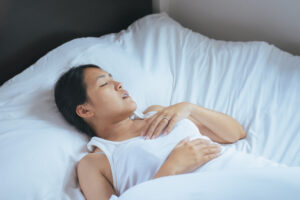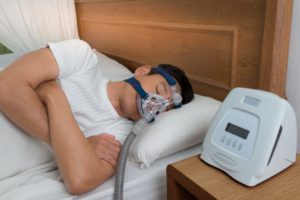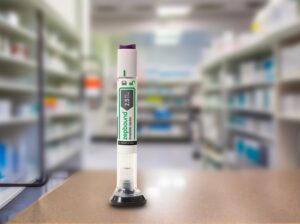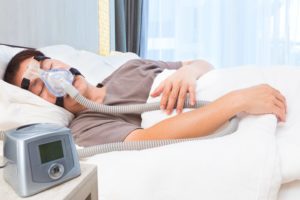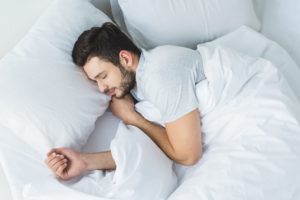When you buy through our links, we may earn a commission. Products or services may be offered by an affiliated entity. Learn more.
Can Sleep Apnea Be Cured?
Sleep apnea is considered a chronic condition, and though it can be effectively treated, it usually cannot be completely cured However, depending on the cause of someone’s sleep apnea, the symptoms and complications of sleep apnea can often be dramatically reduced or fully eliminated
We cover the causes of sleep apnea, whether it goes away naturally, and different types of treatment that can alleviate the condition.
What Causes Sleep Apnea?
Sleep apnea is a disorder in which a person experiences multiple periods of stopped or shallow breathing while they sleep There are two main causes of sleep apnea. Most often, sleep apnea arises due to physical blockage of the windpipe, in which is referred to as obstructive sleep apnea (OSA) Another type of sleep apnea, called central sleep apnea (CSA), occurs when the brain fails to properly control breathing.
Think You May Have Sleep Apnea? Get Help Today

our partner at sleepdoctor.com
10% off Home Sleep Tests
Buy Now“Truly grateful for this home sleep test. Fair pricing and improved my sleep!”
Dawn G. – Verified Tester
Obstructive Sleep Apnea
During sleep, muscles in the upper airway relax, and the airway becomes narrower as a result Obstructive sleep apnea arises when the airway repeatedly collapses to slow or block breathing, which lowers oxygen levels and causes sleep interruptions
The chances of developing obstructive sleep apnea depend in part on how much space is occupied by soft tissues in the airway . Someone may be more likely to experience OSA if they have:
- A lower jaw that is set back relative to the rest of the face
- A large tongue
- More soft tissue near the airway due to genetics or obesity
- Enlarged tonsils, which is particularly common in children
Various other individual risk factors can also contribute to the narrowing of the upper airway. For example, sleeping on one’s back, using alcohol or sedatives, having nasal congestion, or having lower lung volume related to obesity may affect how well the upper airway stays open during sleep.
Central Sleep Apnea
In the most common form of central sleep apnea (CSA), a sleeper breathes more deeply or quickly than usual , which prompts the brain to briefly stop sending signals to continue breathing This causes carbon dioxide levels to rise, leading the sleeper to take more deep or rapid breaths, triggering a recurring cycle of disrupted respiratory patterns and periods of stopped breathing
Central sleep apnea is not as common as obstructive sleep apnea The condition tends to occur in connection with other health conditions, such as stroke, heart failure, or opioid drug use CSA occurs more frequently in older adults and people of male sex Some people may also experience short-term CSA symptoms when they ascend to high altitudes .
Does Sleep Apnea Go Away Naturally?
It is extremely rare for sleep apnea in adults to resolve on its own Without taking active steps to improve breathing during sleep , OSA can be expected to continue, leading to poor sleep and potentially serious health complications Similarly, central sleep apnea will not usually get better unless the underlying issues that cause it are addressed
In rare cases, certain treatments, such as surgery to modify tissues near the airway or significant weight loss, may fully address the airway blockages that cause OSA. In some cases, treating an underlying condition can stop breathing disruptions from central sleep apnea
In this way, sleep apnea does not go away naturally, but various approaches can decrease its impact. While this sometimes resolves the condition entirely, in most adults sleep apnea symptoms need to be managed on an ongoing basis
In children, treatment for obstructive sleep apnea is more likely to lead to a long-term elimination of the condition .
Sleep Apnea in Young Children
Obstructive sleep apnea in young children can sometimes be resolved with surgical procedures and orthodontics Two techniques called adenotonsillectomy and rapid maxillary expansion often result in significant improvement to OSA symptoms, especially when both procedures are performed
- Adenotonsillectomy: This surgery removes the tonsils at the back of the throat and the adenoids that sit behind the nasal cavity Adenotonsillectomy may be appropriate for children with larger-than-usual adenoids and tonsils or for children with risk factors for OSA For many children, adenotonsillectomy eliminates OSA, although it is possible for symptoms to reappear if the adenoids and tonsils grow back or if body changes from puberty or weight gain cause narrowing of the upper airway
- Rapid maxillary expansion: Certain children who have not gone through puberty may be treated with an orthodontic procedure called rapid maxillary expansion This procedure widens the nasal passages and the roof of the mouth, which is called the palate To achieve this, a dental appliance is attached to the top of the mouth and the back teeth Rapid maxillary expansion is most effective for children who have a narrow palate and whose OSA is not caused by enlarged adenoids or tonsils
- Other surgeries: For some children, OSA occurs due to a combination of factors that affect more than one part of the airway These children may need multiple surgical procedures to clear obstructions
For young children with mild to moderate sleep apnea, some experts recommend waiting for a few months to see if obstructive sleep apnea clears up on its own before performing surgery In the meantime, lifestyle changes to reduce congestion and improve sleep habits can help manage symptoms.
How to Reduce Your Risk of Sleep Apnea
One way to reduce the risk of developing sleep apnea or to manage sleep apnea symptoms is to address factors that contribute to disrupted breathing during sleep.
- Lose weight: For people with overweight or obesity, losing weight can help control sleep apnea symptoms, although it usually does not cure the condition completely . A doctor can suggest the best way to lose weight at a healthy rate and may recommend drug therapy or bariatric surgery for weight loss
- Avoid back sleeping: OSA symptoms are generally worse when back sleeping, especially for people with few other risk factors As part of a larger treatment plan, sleeping on one’s side may contribute to better breathing during sleep
- Raise the head of the bed: Experts sometimes recommend raising the head of the bed or using a large wedge pillow to prop up the upper body because these may help keep the airway open
- Treat allergies: Allergens, tobacco smoke, and other environmental pollutants can cause nasal congestion that exacerbates symptoms of obstructive sleep apnea Taking steps to reduce allergens in the bedroom may help When these substances are difficult to avoid, using a saline spray or medications may decrease congestion
- Quit smoking: Research suggests that people who smoke are up to three times more likely to have symptoms of obstructive sleep apnea Even for those who do not smoke, being around tobacco smoke can aggravate inflammation and increase symptoms of obstructive sleep apnea
- Avoid alcohol before bed: Alcohol, sedatives, and certain other medications can dampen activity in the central nervous system, which may increase the risk of OSA symptoms Limiting use of these substances before bedtime may reduce their impact on breathing during sleep
Sleep Apnea Treatment Options
Sleep apnea treatment aims to eliminate breathing disruptions during sleep and improve sleep quality. For people with obstructive sleep apnea, this means keeping the airway open. For people with central sleep apnea, this means addressing underlying causes of irregular breathing patterns or using treatments to better control breathing.
“Although it is less common to fully cure sleep apnea, very effective and safe treatments exist such as PAP therapy and several non PAP therapies. Over a 100 variations of PAP interfaces exist and working with a sleep physician can often lead to the combination that may be suitable for you”
Dr. Abhinav Singh, Sleep Physician
Positive Airway Pressure (PAP) Therapy
In positive airway pressure (PAP) therapy, users wear a mask over the nose or the nose and mouth The mask is connected to a PAP machine and delivers a stream of pressurized air to the upper airway
For people with OSA, the air pressure helps hold the airway open, and consistent use of a PAP device has been shown to effectively reduce breathing disruptions, enhance sleep, and improve quality of life PAP therapy provides the most benefits for people with severe OSA
Although there is less research on PAP therapy for central sleep apnea, studies suggest that PAP machines are effective in encouraging more stable respiration with fewer lapses in breathing
PAP therapy does not cure sleep apnea, and it only works when the sleeper uses the device However, some people find using a PAP machine or wearing the mask to be uncomfortable In fact, as many as 50% of people stop using their PAP device, causing symptoms to come back A doctor can usually suggest practical steps to make using a PAP device more comfortable.
Types of PAP devices include:
- CPAP: With continuous positive airway pressure (CPAP) therapy, the mask is set to blow air at a steady rate to keep the airway open
- BiPAP: Bilevel PAP, also known as BiPAP or BPAP, delivers air at one pressure level when breathing in and another when breathing out
- APAP: In auto-titrating PAP (APAP), the machine detects changes in breathing and adjusts air pressure accordingly
- ASV: Adaptive servo-ventilation (ASV) is a less commonly used form of PAP therapy that dynamically modifies air pressure levels during inhalation to offer breathing assistance that matches an individual’s needs. ASV may be used for certain types of central sleep apnea
Oral Appliances
Oral appliances are worn during sleep to keep the airway open The two most common types are mandibular advancement devices, which bring the jaw forward, and tongue retaining devices, which prevent the tongue from slipping back and blocking the airway Oral appliances are custom-fitted to a person’s mouth by a dentist, and while they can reduce OSA symptoms, they are generally less effective than PAP therapy
Mouth and Throat Exercises
Mouth and throat exercises aim to strengthen muscles so they are less likely to fall into a position that blocks the airway during sleep Studies suggest these exercises may help reduce mouth breathing and marginally improve sleep apnea symptoms, but more research is needed to fully validate the extent of their benefits
Surgery
Sleep apnea surgery for adults is most likely to work in people who have a clear anatomical reason for their OSA, such as large tonsils or a jaw that is set back significantly OSA surgery has varying rates of success, and even when surgery is initially effective, sleep apnea can sometimes recur in the future
Hypoglossal Nerve Stimulation
People whose symptoms do not get better with PAP therapy may elect to have hypoglossal nerve surgery in which doctors implant a device that activates the nerves running to the tongue . The goal of this treatment is to stimulate the tissue so that it does not fall back and block the airway, and evidence suggests it can reduce symptoms in certain people with OSA
Phrenic Nerve Stimulation
To treat central sleep apnea, doctors may implant a device to stimulate the phrenic nerve, which causes the diaphragm to contract as required for breathing This type of treatment may offer benefits by compensating for the brain’s irregular control of breathing in people with CSA.
Medication
Medication is not the first choice for treating sleep apnea as there is limited research on its effectiveness and it may carry side effects However, some people with central sleep apnea may be prescribed medicine to aid breathing if other types of treatment are not effective

Still have questions? Ask our community!
Join our Sleep Care Community — a trusted hub of sleep health professionals, product specialists, and people just like you. Whether you need expert sleep advice for your insomnia or you’re searching for the perfect mattress, we’ve got you covered. Get personalized guidance from the experts who know sleep best.
References
9 Sources
-
Badr, M. S. (2022, April 15). Pathophysiology of upper airway obstruction in obstructive sleep apnea in adults. In N. Collop (Ed.). UpToDate., Retrieved April 5, 2023, from
https://www.uptodate.com/contents/pathophysiology-of-upper-airway-obstruction-in-obstructive-sleep-apnea-in-adults -
Badr, M. S. (2023, March 9). Central sleep apnea: Pathogenesis. In R. D. Chervin (Ed.). UpToDate., Retrieved April 5, 2023, from
https://www.uptodate.com/contents/central-sleep-apnea-pathogenesis -
Badr, M. S. (2021, September 30). Central sleep apnea: Risk factors, clinical presentation, and diagnosis. In R. D. Chervin (Ed.). UpToDate., Retrieved April 5, 2023, from
https://www.uptodate.com/contents/central-sleep-apnea-risk-factors-clinical-presentation-and-diagnosis -
Kryger, M. H. & Malhotra, A. (2023, March 24). Obstructive sleep apnea: Overview of management in adults. In N. Collop (Ed.). UpToDate., Retrieved April 5, 2023, from
https://www.uptodate.com/contents/obstructive-sleep-apnea-overview-of-management-in-adults -
Paruthi, S. (2021, January 14). Management of obstructive sleep apnea in children. In R. D. Chervin (Ed.). UpToDate., Retrieved April 5, 2023, from
https://www.uptodate.com/contents/management-of-obstructive-sleep-apnea-in-children -
UpToDate. (n.d.). Patient education: Sleep apnea in adults (The basics). UpToDate., Retrieved April 5, 2023, from
https://www.uptodate.com/contents/sleep-apnea-in-adults-the-basics -
Kline, L. R. (2023, January 13). Clinical presentation and diagnosis of obstructive sleep apnea in adults. In N. Collop (Ed.). UpToDate., Retrieved April 5, 2023, from
https://www.uptodate.com/contents/clinical-presentation-and-diagnosis-of-obstructive-sleep-apnea-in-adults -
Strohl, K. P. (2022, October). Sleep apnea. Merck Manual Consumer Version., Retrieved April 5, 2023, from
https://www.merckmanuals.com/home/lung-and-airway-disorders/sleep-apnea/sleep-apnea -
Suurna, M. (2022, October 6). Hypoglossal nerve stimulation for adult patients with obstructive sleep apnea. In N. Collop (Ed.). UpToDate., Retrieved April 5, 2023, from
https://www.uptodate.com/contents/hypoglossal-nerve-stimulation-for-adult-patients-with-obstructive-sleep-apnea




